Charlottesville, VA, Mini-Reunion
October 11-14, 2012
Click here to see our entire Charlottesville Photo Album
From Thursday, October
11, through Sunday, October 14, about 80 classmates and companions participated
in the sixth Class of 1969 mini-Reunion, held in Charlottesville, VA. The theme for the intellectual component of this
year’s Mini-Reunion was The Virginia
Dynasty, with a special emphasis on James
Madison: Virginian; Princetonian; Founding Father; primary author of the
Constitution and the Bill of Rights; secretary of state; war president; planter
and slave-owner, among many other roles. After all, 2012 is the bicentennial of
the first year of the War of 1812.
There
may be no "major war” in American history about which we understand so little
as the War of 1812. Some called it
the "Second American Revolution.”
The opponents tended to call it "Mr. Madison’s War.” As middle-school history students we
learned about Old Ironsides, Fort McHenry, the Battle of Lake Erie, Jackson and
the Battle of New Orleans, and maybe the burning of the White House; but not
about what it all meant in a larger context. What did President Madison and his war cabinet hope to
achieve with this war? Who fought
the war, who opposed it, and who would have preferred to sit it out? Did the young United States really
prevail?
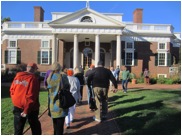 The obvious focus tour for a Madison-themed trip
was his home, Montpelier, in Orange
County, Virginia, not far from Charlottesville. The terrific idea of centering
the Mini near Charlottesville, however, meant that it could be more broadly
themed than just Montpelier. Many
P’69ers with an interest in history and a bent for travel had been to Thomas Jefferson’s Monticello
already. Fewer had been to
Montpelier, or to James Monroe’s Ash
Lawn/Highland, and almost no one had been to Jefferson’s secret second home
in Lynchburg, called Poplar Forest.
The obvious focus tour for a Madison-themed trip
was his home, Montpelier, in Orange
County, Virginia, not far from Charlottesville. The terrific idea of centering
the Mini near Charlottesville, however, meant that it could be more broadly
themed than just Montpelier. Many
P’69ers with an interest in history and a bent for travel had been to Thomas Jefferson’s Monticello
already. Fewer had been to
Montpelier, or to James Monroe’s Ash
Lawn/Highland, and almost no one had been to Jefferson’s secret second home
in Lynchburg, called Poplar Forest.
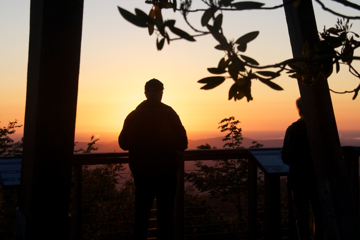 We were fortunate to
have a beautifully scenic and comfortable venue to serve as Mini
Headquarters: the Wintergreen Resort, where Rod and Martha Ferguson have a home as
well as a renowned brew-pub, only about 45 minutes from Charlottesville by
bus. Being
nestled in chalet condos in the autumn-leaved hills of the Shenandoah
Valley for a '69er Mini-Reunion, with three former presidential estates
beckoning us, has come to feel routine for this great class. Virginia
seems to have been an extremely fertile land for the emergence of idealists,
revolutionaries and brilliant visionaries.
We were fortunate to
have a beautifully scenic and comfortable venue to serve as Mini
Headquarters: the Wintergreen Resort, where Rod and Martha Ferguson have a home as
well as a renowned brew-pub, only about 45 minutes from Charlottesville by
bus. Being
nestled in chalet condos in the autumn-leaved hills of the Shenandoah
Valley for a '69er Mini-Reunion, with three former presidential estates
beckoning us, has come to feel routine for this great class. Virginia
seems to have been an extremely fertile land for the emergence of idealists,
revolutionaries and brilliant visionaries.
Following
a Welcome Reception Thursday evening, the formal events began on Friday morning
with our first estate visit, exquisitely-furnished Montpelier. Its
restorative gardens and forests served as the backdrop for Madison's
contemplations on the Constitution. He and Dolley appeared to have been
the original "power couple" and their influence on the times seems
palpable even today.
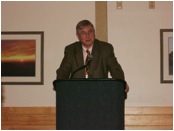 We
picked up our mentor for the day, J.C.A.
(John) Stagg, as we drove through Charlottesville. Professor Stagg—Princeton Ph.D. 1973—is
the editor of The Papers of James Madison and a member of the history faculty
at the University of Virginia.
Many of us had read his new book, The
War of 1812: Conflict for a Continent (Cambridge Univ. Press, 2012) in
preparation for the Mini.
We
picked up our mentor for the day, J.C.A.
(John) Stagg, as we drove through Charlottesville. Professor Stagg—Princeton Ph.D. 1973—is
the editor of The Papers of James Madison and a member of the history faculty
at the University of Virginia.
Many of us had read his new book, The
War of 1812: Conflict for a Continent (Cambridge Univ. Press, 2012) in
preparation for the Mini.
During the bus rides to
and from Montpelier, Professor Stagg took the microphone to give us a short
course on a topic he assured us we would not hear about during the tours: the marriage of James and Dolley
Madison. Seems neither of these
remarkable individuals was quite the same person in private as in public. How’s that for a teaser!
 The house itself is
about 90% restored from its days in the DuPont family, and it is interesting
from a number of different perspectives.
After years of debate, the owners of the house (the National Trust for
Historic Preservation) decided to convert the structure from a 100+ room
mansion back to what it was when the Madisons were in residence: an 11-room
country house.
The house itself is
about 90% restored from its days in the DuPont family, and it is interesting
from a number of different perspectives.
After years of debate, the owners of the house (the National Trust for
Historic Preservation) decided to convert the structure from a 100+ room
mansion back to what it was when the Madisons were in residence: an 11-room
country house.
At Montpelier, the professional staff met us at the
bus doors and led us into the magnificent new visitor center. We had divided into four sub-groups so
that two of the groups could proceed directly to their house tours and the
other two could participate in what Montpelier calls "Expert Experiences.” Ninety minutes later the groups
switched positions. Each Expert
Experience featured a senior member of the professional staff—Restoration,
Curatorial, Archaeological, Constitution—giving us an intensive and insightful
look into the Madisons and their home.
We learned later that it was the first time the staff had conducted all
four experiences for the same group on the same day.
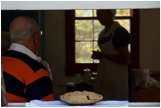
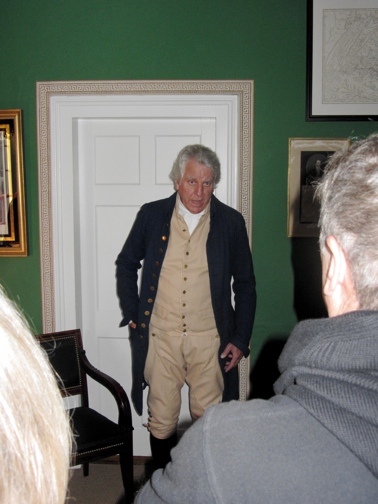 As for Monroe, the highlights of his more
modest Ash Lawn Highland home were an apple pie baking demonstration (the
old-fashioned way), an inspiring room of flags ... and the President
himself. It felt totally natural to be swept into meeting this welcoming
president in a small, stately room of his house. His discourse on the
responsibilities and burdens of the time and his hints about his relationships
with his other friends in high places were enlightening.
As for Monroe, the highlights of his more
modest Ash Lawn Highland home were an apple pie baking demonstration (the
old-fashioned way), an inspiring room of flags ... and the President
himself. It felt totally natural to be swept into meeting this welcoming
president in a small, stately room of his house. His discourse on the
responsibilities and burdens of the time and his hints about his relationships
with his other friends in high places were enlightening.
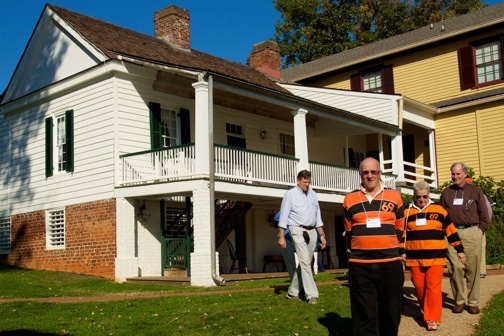 What impressed all of us about Ash Lawn/Highland
was its near-complete contrast to Montpelier. It presents today, and it must have presented in Monroe’s
day, as a functioning family farm.
It is practically adjacent to Monticello, which was not an accident
because Jefferson recruited Monroe (among others) to move from other parts of
Virginia to the Piedmont so he could maintain his circle of enlightened friends
in his retirement.
What impressed all of us about Ash Lawn/Highland
was its near-complete contrast to Montpelier. It presents today, and it must have presented in Monroe’s
day, as a functioning family farm.
It is practically adjacent to Monticello, which was not an accident
because Jefferson recruited Monroe (among others) to move from other parts of
Virginia to the Piedmont so he could maintain his circle of enlightened friends
in his retirement.
 The bus trip back to
Wintergreen gave us some rest time before we convened for a grand reception and
dinner featuring much P’69 regalia.
After dinner, Professor Stagg gave our keynote address for the Mini,
presenting the latest research about Madison and the War of 1812. Among his other conclusions, he said we
should ignore what we may have heard about "the War Hawks” (Henry Clay, John
Calhoun and the like) pushing the young nation into war. This was Mr. Madison’s War all right.
The bus trip back to
Wintergreen gave us some rest time before we convened for a grand reception and
dinner featuring much P’69 regalia.
After dinner, Professor Stagg gave our keynote address for the Mini,
presenting the latest research about Madison and the War of 1812. Among his other conclusions, he said we
should ignore what we may have heard about "the War Hawks” (Henry Clay, John
Calhoun and the like) pushing the young nation into war. This was Mr. Madison’s War all right.
 Jefferson's
Monticello, the image of which we've all carried in our pockets since
childhood, is a remarkable edifice. Here was a man who slept partially
propped up (because it's good for you) and seemed to micro-organize every
detail of his life -- from intricate artifacts from around the globe (animal
bones and skins, and up-to-the-moment inventions) to a
2-story,pulley-operated wall calendar -- all displayed in a splendid
hall. He kept records of meals, visitors, the minutest of
expenditures. Science and nature equally intrigued him with his
letter-copying machine vying for attention with his extensive fruit, vegetable and
flower gardens. Here certainly was a man who, while forming and guiding a
new country, was also side-by-side with enslaved peoples. We hope,
assume, and have been told he struggled with the issue of liberty and fairness
and supposed economic necessity. The tour of the slave quarters and the
stories of the people were riveting and weighed heavily on the heart.
Jefferson's
Monticello, the image of which we've all carried in our pockets since
childhood, is a remarkable edifice. Here was a man who slept partially
propped up (because it's good for you) and seemed to micro-organize every
detail of his life -- from intricate artifacts from around the globe (animal
bones and skins, and up-to-the-moment inventions) to a
2-story,pulley-operated wall calendar -- all displayed in a splendid
hall. He kept records of meals, visitors, the minutest of
expenditures. Science and nature equally intrigued him with his
letter-copying machine vying for attention with his extensive fruit, vegetable and
flower gardens. Here certainly was a man who, while forming and guiding a
new country, was also side-by-side with enslaved peoples. We hope,
assume, and have been told he struggled with the issue of liberty and fairness
and supposed economic necessity. The tour of the slave quarters and the
stories of the people were riveting and weighed heavily on the heart.
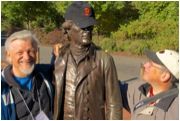 Many of us posed with a
Princeton-capped Jefferson statue (most of us were taller -- though not the two in this photo!). Maybe he, and not Burr, went
to P.U.
Many of us posed with a
Princeton-capped Jefferson statue (most of us were taller -- though not the two in this photo!). Maybe he, and not Burr, went
to P.U.
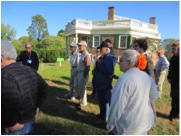 Poplar Forest was an unexpected treat, in the great
tradition of P’69 Minis. Viewed
first from a long lane that approaches the house through the woods, it is
immediately clear that only Thomas Jefferson could have designed the house. This
octagonal house (likely the first in the country) was presided over by
heaven-high tulip poplars. Its
restoration is far from complete, and is likely to take another couple of
decades because of funding shortages, making it all the more interesting as a
living museum of the restoration process in which many elements of the
underlying structure are visible. Jefferson's awareness of the
interplay of light, glass and furniture placement was again apparent.
Poplar Forest was an unexpected treat, in the great
tradition of P’69 Minis. Viewed
first from a long lane that approaches the house through the woods, it is
immediately clear that only Thomas Jefferson could have designed the house. This
octagonal house (likely the first in the country) was presided over by
heaven-high tulip poplars. Its
restoration is far from complete, and is likely to take another couple of
decades because of funding shortages, making it all the more interesting as a
living museum of the restoration process in which many elements of the
underlying structure are visible. Jefferson's awareness of the
interplay of light, glass and furniture placement was again apparent.
Poplar
Forest is 90 minutes south of Monticello by bus, but it was two or three days
by wagon in the early 1800s.
Jefferson liked to spend at least a month or two at Poplar Forest each
year in his retirement, but he famously also "holed up” there in 1814 during
the British invasion of Maryland when he was advised he would not be safe at
Monticello.
The Presidents were charismatic personages, but
bankruptcy awaited their estates upon their deaths. Thankfully, in the present
time, their homes continue to be recreated and revitalized in painstaking
fashion.
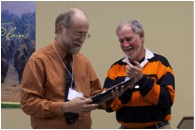 Our mentor for the Jefferson tours on
Saturday, J. Jefferson (Jeff) Looney—Princeton
Ph.D. 1983—is the editor of The Papers of Thomas Jefferson Retirement Series at
the Thomas Jefferson Foundation.
Dr. Looney met us at the Monticello visitor center, gave us a
presentation about Jefferson (allowing for plentiful and provocative Q&A)
over box lunches, and accompanied us on the bus rides to and from Poplar Forest
that afternoon. Jeff proudly
displayed one of his collection of Princeton class ties, and President Bill Charrier presented him with a ‘69
tie to add to the collection.
Our mentor for the Jefferson tours on
Saturday, J. Jefferson (Jeff) Looney—Princeton
Ph.D. 1983—is the editor of The Papers of Thomas Jefferson Retirement Series at
the Thomas Jefferson Foundation.
Dr. Looney met us at the Monticello visitor center, gave us a
presentation about Jefferson (allowing for plentiful and provocative Q&A)
over box lunches, and accompanied us on the bus rides to and from Poplar Forest
that afternoon. Jeff proudly
displayed one of his collection of Princeton class ties, and President Bill Charrier presented him with a ‘69
tie to add to the collection.
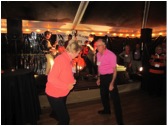 The fine conversations on the bus rides
were, as always, a given and the beer (nationally award-winning, just days
before in Denver) flowed as freely as of old, backed by the sausage-inspired
fare at hosts Rod and Martha Ferguson's
Devil's Backbone Brewery.
The fine conversations on the bus rides
were, as always, a given and the beer (nationally award-winning, just days
before in Denver) flowed as freely as of old, backed by the sausage-inspired
fare at hosts Rod and Martha Ferguson's
Devil's Backbone Brewery.
 Those
who ventured out in the mornings were treated to expansive Shenandoah
sunrises. Those who hiked and crossed the Appalachian Trail on Sunday
through golden-leaved, shaggy-treed woods with two so informative, so pleasant
guides capped off a very fine long weekend with a peaceful flair.
Those
who ventured out in the mornings were treated to expansive Shenandoah
sunrises. Those who hiked and crossed the Appalachian Trail on Sunday
through golden-leaved, shaggy-treed woods with two so informative, so pleasant
guides capped off a very fine long weekend with a peaceful flair.
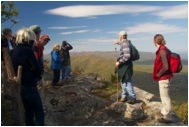
 We stood on ancient rocks musing about past
eons and imagined this robust valley 200 years ago (almost making
out the 3-day-horse-ride rest stops between Jefferson's homes).
We stood on ancient rocks musing about past
eons and imagined this robust valley 200 years ago (almost making
out the 3-day-horse-ride rest stops between Jefferson's homes).
Maybe it's true:
Virginia is for Lovers,
for Presidents and for Princeton adventurers.
Text: Claus Frank, Bruce
DeBolt, Jeff Kaplan
Photos: Bill Charrier,
Claus Frank, Jeff Kaplan, Curt Kehr, Niel Lewis



 The obvious focus tour for a Madison-themed trip
was his home,
The obvious focus tour for a Madison-themed trip
was his home,  We were fortunate to
have a beautifully scenic and comfortable venue to serve as Mini
Headquarters: the
We were fortunate to
have a beautifully scenic and comfortable venue to serve as Mini
Headquarters: the  We
picked up our mentor for the day,
We
picked up our mentor for the day,  The house itself is
about 90% restored from its days in the DuPont family, and it is interesting
from a number of different perspectives.
After years of debate, the owners of the house (the National Trust for
Historic Preservation) decided to convert the structure from a 100+ room
mansion back to what it was when the Madisons were in residence: an 11-room
country house.
The house itself is
about 90% restored from its days in the DuPont family, and it is interesting
from a number of different perspectives.
After years of debate, the owners of the house (the National Trust for
Historic Preservation) decided to convert the structure from a 100+ room
mansion back to what it was when the Madisons were in residence: an 11-room
country house.
 As for Monroe, the highlights of his more
modest Ash Lawn Highland home were an apple pie baking demonstration (the
old-fashioned way), an inspiring room of flags ... and the President
himself. It felt totally natural to be swept into meeting this welcoming
president in a small, stately room of his house. His discourse on the
responsibilities and burdens of the time and his hints about his relationships
with his other friends in high places were enlightening.
As for Monroe, the highlights of his more
modest Ash Lawn Highland home were an apple pie baking demonstration (the
old-fashioned way), an inspiring room of flags ... and the President
himself. It felt totally natural to be swept into meeting this welcoming
president in a small, stately room of his house. His discourse on the
responsibilities and burdens of the time and his hints about his relationships
with his other friends in high places were enlightening. What impressed all of us about Ash Lawn/Highland
was its near-complete contrast to Montpelier. It presents today, and it must have presented in Monroe’s
day, as a functioning family farm.
It is practically adjacent to Monticello, which was not an accident
because Jefferson recruited Monroe (among others) to move from other parts of
Virginia to the Piedmont so he could maintain his circle of enlightened friends
in his retirement.
What impressed all of us about Ash Lawn/Highland
was its near-complete contrast to Montpelier. It presents today, and it must have presented in Monroe’s
day, as a functioning family farm.
It is practically adjacent to Monticello, which was not an accident
because Jefferson recruited Monroe (among others) to move from other parts of
Virginia to the Piedmont so he could maintain his circle of enlightened friends
in his retirement. The bus trip back to
Wintergreen gave us some rest time before we convened for a grand reception and
dinner featuring much P’69 regalia.
After dinner, Professor Stagg gave our keynote address for the Mini,
presenting the latest research about Madison and the War of 1812. Among his other conclusions, he said we
should ignore what we may have heard about "the War Hawks” (Henry Clay, John
Calhoun and the like) pushing the young nation into war. This was Mr. Madison’s War all right.
The bus trip back to
Wintergreen gave us some rest time before we convened for a grand reception and
dinner featuring much P’69 regalia.
After dinner, Professor Stagg gave our keynote address for the Mini,
presenting the latest research about Madison and the War of 1812. Among his other conclusions, he said we
should ignore what we may have heard about "the War Hawks” (Henry Clay, John
Calhoun and the like) pushing the young nation into war. This was Mr. Madison’s War all right. Jefferson's
Monticello, the image of which we've all carried in our pockets since
childhood, is a remarkable edifice. Here was a man who slept partially
propped up (because it's good for you) and seemed to micro-organize every
detail of his life -- from intricate artifacts from around the globe (animal
bones and skins, and up-to-the-moment inventions) to a
2-story,pulley-operated wall calendar -- all displayed in a splendid
hall. He kept records of meals, visitors, the minutest of
expenditures. Science and nature equally intrigued him with his
letter-copying machine vying for attention with his extensive fruit, vegetable and
flower gardens. Here certainly was a man who, while forming and guiding a
new country, was also side-by-side with enslaved peoples. We hope,
assume, and have been told he struggled with the issue of liberty and fairness
and supposed economic necessity. The tour of the slave quarters and the
stories of the people were riveting and weighed heavily on the heart.
Jefferson's
Monticello, the image of which we've all carried in our pockets since
childhood, is a remarkable edifice. Here was a man who slept partially
propped up (because it's good for you) and seemed to micro-organize every
detail of his life -- from intricate artifacts from around the globe (animal
bones and skins, and up-to-the-moment inventions) to a
2-story,pulley-operated wall calendar -- all displayed in a splendid
hall. He kept records of meals, visitors, the minutest of
expenditures. Science and nature equally intrigued him with his
letter-copying machine vying for attention with his extensive fruit, vegetable and
flower gardens. Here certainly was a man who, while forming and guiding a
new country, was also side-by-side with enslaved peoples. We hope,
assume, and have been told he struggled with the issue of liberty and fairness
and supposed economic necessity. The tour of the slave quarters and the
stories of the people were riveting and weighed heavily on the heart.  Many of us posed with a
Princeton-capped Jefferson statue (most of us were taller -- though not the two in this photo!). Maybe he, and not Burr, went
to P.U.
Many of us posed with a
Princeton-capped Jefferson statue (most of us were taller -- though not the two in this photo!). Maybe he, and not Burr, went
to P.U. Poplar Forest was an unexpected treat, in the great
tradition of P’69 Minis. Viewed
first from a long lane that approaches the house through the woods, it is
immediately clear that only Thomas Jefferson could have designed the house. This
octagonal house (likely the first in the country) was presided over by
heaven-high tulip poplars. Its
restoration is far from complete, and is likely to take another couple of
decades because of funding shortages, making it all the more interesting as a
living museum of the restoration process in which many elements of the
underlying structure are visible. Jefferson's awareness of the
interplay of light, glass and furniture placement was again apparent.
Poplar Forest was an unexpected treat, in the great
tradition of P’69 Minis. Viewed
first from a long lane that approaches the house through the woods, it is
immediately clear that only Thomas Jefferson could have designed the house. This
octagonal house (likely the first in the country) was presided over by
heaven-high tulip poplars. Its
restoration is far from complete, and is likely to take another couple of
decades because of funding shortages, making it all the more interesting as a
living museum of the restoration process in which many elements of the
underlying structure are visible. Jefferson's awareness of the
interplay of light, glass and furniture placement was again apparent. Our mentor for the Jefferson tours on
Saturday,
Our mentor for the Jefferson tours on
Saturday,  The fine conversations on the bus rides
were, as always, a given and the beer (nationally award-winning, just days
before in Denver) flowed as freely as of old, backed by the sausage-inspired
fare at hosts
The fine conversations on the bus rides
were, as always, a given and the beer (nationally award-winning, just days
before in Denver) flowed as freely as of old, backed by the sausage-inspired
fare at hosts  Those
who ventured out in the mornings were treated to expansive Shenandoah
sunrises. Those who hiked and crossed the Appalachian Trail on Sunday
through golden-leaved, shaggy-treed woods with two so informative, so pleasant
guides capped off a very fine long weekend with a peaceful flair.
Those
who ventured out in the mornings were treated to expansive Shenandoah
sunrises. Those who hiked and crossed the Appalachian Trail on Sunday
through golden-leaved, shaggy-treed woods with two so informative, so pleasant
guides capped off a very fine long weekend with a peaceful flair.
 We stood on ancient rocks musing about past
eons and imagined this robust valley 200 years ago (almost making
out the 3-day-horse-ride rest stops between Jefferson's homes).
We stood on ancient rocks musing about past
eons and imagined this robust valley 200 years ago (almost making
out the 3-day-horse-ride rest stops between Jefferson's homes).